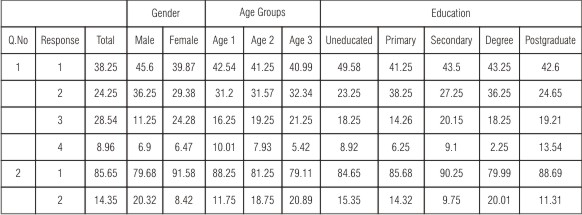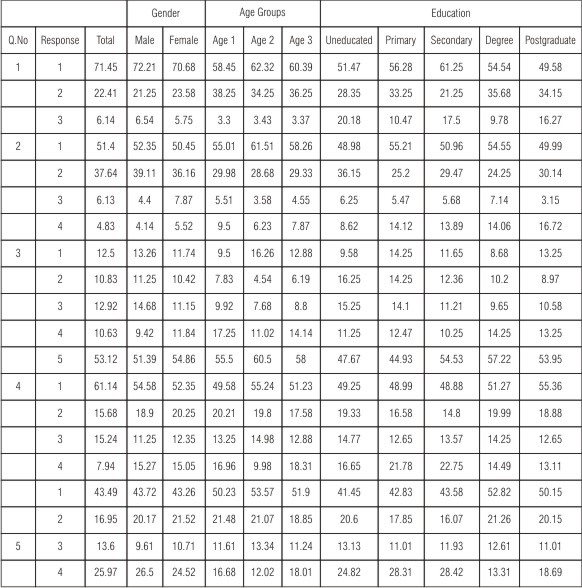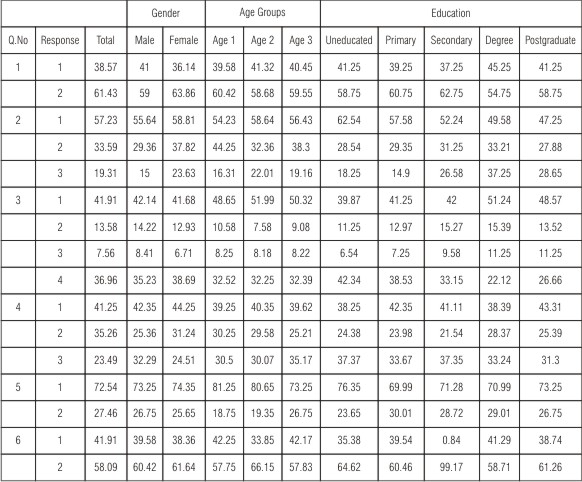Introduction
Dental implant is an artificial tooth root fixed into the jaws to hold a replacement tooth or bridge. They are an ideal option for people in good general oral health who have lost a tooth or teeth due to periodontal disease, failure of endodontics, an injury or for any other reason. They are also used for the treatment of edentulous patients and are associated with improved denture retention, stability, functional efficiency, and thus improving the quality of life.1,2,3 At present, they are widely practiced as a treatment priority of completely or partially edentulous patients leading to widespread acceptance and popularity of dental implants within the dental professional community4
Dental implants are proved to be having high efficacy rates which is evident from several long term clinical trials2,3. Patients' acceptance of dental implants was found to be high. Grogono et al5 in his study reported that, 88% of the sample had an increase in their self confidence after implant treatment, 89% said that they would accept to go through implant treatment procedure again, and 98% said their oral health had generally improved. Similarly several other studies reported that patients after implant therapy were highly satisfied with the esthetic results, function, and were willing to undergo the same procedure again6
Level of awareness about dental implant treatment varied among several studies in different countries. Public awareness, positive attitude and acceptance of dental implants were found to be high in a study conducted in America. Reports from Finland7 found low levels of awareness among patients about dental implant treatment procedures. A survey report from Austria8 reported that the awareness rate of dental implant procedure was 72%, and 42% of those who questioned said that they were not informed at all about dental implants, while only 4% said they were well informed about dental implants. The study concluded that the information about conventional dentistry was only marginally higher than that about implant dentistry.
Source of information plays a key role in improving the level of awareness of dental implants which can be provided by various means. In some countries like United States media played a major role in public dental education when compared to the contribution from dentists9. Similarly, In Japan, a study showed that dentists provided no more than 20% of the information about dental implants10. While other report8 showed that, dentist played a major role in providing information about implants to patients followed by print media and by friends and acquaintances. Berge concluded that mass media like periodicals, TV, and broadcasts are reported to be the main sources of mostly negative information about dental implants4,11 and that the treatment cost, fear of surgery, and long post surgical period may prevent people from undergoing dental implant treatment. Similarly few other studies8 revealed misinformation or incomplete information and false beliefs of the public towards implants in terms of a major information gap.
As India is still considered as a developing country, with people having low levels of literacy and awareness regarding dental implants and their uses, there is paucity of information regarding the awareness of patients about dental implants in this country. Considering this, a study was conducted with an aim to assess the sources, level of awareness, and need for information about dental implants among patients attending the outpatient ward of department of Prosthodontics and private dental clinics in Khammam, Andhra Pradesh, India.
Materials And Method
This Questionnaire based survey was conducted during August 2011 for a period of 10 days. All patients attending the outpatient department of Prosthodontics in Mamata dental college and private dental clinics in Khammam were included. They were informed about the aims and objectives of the study after which a verbal consent was obtained for their participation. Those who were not willing to participate were excluded.
Ethical Clearance was obtained from the ethical committee of Mamata Dental College and Hopsital, Khammam, India.
A self explanatory questionnaire was designed to assess the patient's knowledge and awareness about dental implants. It consists of 14 questions in 3 sections, first section includes source of information about dental implants, second section consists of questions evaluating the level of information about implants and finally third section consists of questions that find out the need of dental implants as a treatment option. The questionnaire was prepared bilingually (English and Telugu) to correspond with the reading and comprehension levels of patients with different levels of education.
Questionnaire was pilot tested on a representative sample of 20 patients. Test-retest reliability was performed to test the reliability and internal consistency of the questionnaire, it was found to be good with Cronbach's alpha (α) 0.75
The questionnaires were handed to the patients during their regular dental visits. The collected data was analyzed by using Statistical Package for Social Sciences 16 (SPSS Inc., Chicago, IL) software. Descriptive statistics were generated to summarize the responses.
Results
Demographic data (Table 1):
In this study, 600 questionnaires were distributed, among these only 535 responded to the questionnaire with a response rate of 89.16%. Of the total sample 319 (59.63%) were males and 216 (40.37%) were females. Nearly half of the patients were in the age group of 31-50 years (48.79), 34.7% were in 15-30 years age group and only 16.45% were above 51 years.
 | Table 1 : Demographic Data Of The Participating Patients N=535
 |
Patient occupation was classified based on their self responses. Here few occupations like laborers, gardeners, mechanics etc. were placed in unskilled group, and occupations like engineers, doctors, inspectors etc in professional group. Majority of the sample were from unskilled group (37.20%) and very few were students (9.16%). Patient education status was also included in our demographic data. Almost half of the patients completed secondary school which is up to 10th standard in this country. Very few patients had post graduation; this distribution corresponds to the statistical data of our country.
Source Of Information (Table 2):
For most of the subjects, dentist was the main source of information about dental implants (38.25%), which is followed by friends and relatives (28.54%). General practitioner played a very minor role in providing information to the patients about implants (8.96%).
 | Table 2 : Patient responses to source of information about implants
 |
When asked about their interest to know about dental implants, 85.65% of them were found to have more interest, only 14.35% were less interested.
Level Of Information About Implants (Table 3):
In our study, 71.45% of the participants felt that missing teeth should be replaced, while 22.25% felt that replacement of teeth is required only if it is aesthetically unpleasant. Only 6.14% of them felt that replacement of teeth is not necessarily required.
 | Table 3: Patient Responses To Level Of Information
 |
When asked about the different alternatives of replacing teeth they know, only 4.83% of the participants were aware about implant supported prosthesis, half of the patients were aware about fixed prosthesis as a means of replacement and 37.64% were aware of removable partial denture. Only 6.13% of the sample knew about removable complete dentures as a means of replacing teeth.
Most of the patients (53.12%) reported that they were least informed about implants while 12.50% felt to be very well informed.
When asked about survival rate of dental implants, majority of them (61.14%) felt that they will survive only for a period of less than 5 years, while 7.94% felt that they would last for life time.
Of the total participants, 43.49% believed that implant failure is due to poor oral hygiene, and 25.97% of them blamed themselves for implant failure. 16.95% felt that failure of implant depends on quality of implant placed and 13.60% believed that it is due to the poor quality of treatment provided by the dentist.
Information About Need For Implants (Table 4):
When patients were asked about their opinion for removable partial denture as a means of replacement, 61.43% of them showed disinterest towards it and favoured fixed prosthesis as their choice for replacing missing teeth.
 | Table 4: Patient Responses To Need For Implants
 |
More than half of the patients (57.23%) felt, high cost as a major barrier for dental implant treatment, one third (33.59%) of them expressed need for surgery as a disadvantage for implant treatment and 19.31% felt that long periods of treatment with many appointments as a disadvantage.
When asked about the advantages of dental implants, fixed nature of it was viewed as major advantage by 41.91% of the patients, while 36.96% of them felt avoidance of grinding of natural teeth as the biggest advantage. Only 7.56% felt, functional improvement as the major advantage.
When asked about the care to be taken for maintaining implants, most of them (41.25%) felt that equal care should be given both for natural teeth and implants, while 35.26% of them felt that implants require less care when compared to natural teeth and only 23.49% believed that they require special care when compared to natural teeth.
Most patients (72.54%) were willing to opt for dental implants while remaining wanted to go for the alternative options. When asked about who should opt for implants 58.09% felt that it was an expensive treatment and only rich and affluent should opt for it as they are not affordable
Discussion
With increasing success rates of implant treatment more patients are opting for dental implants as premier choice for replacement of missing teeth. Rising knowledge of this advanced treatment modality in the society paves way for its ready acceptability. But for this a baseline data on their levels of awareness is required. Thus, a study was conducted to assess the patients' awareness towards dental implants. This kind of survey provides data on patients awareness level, knowledge, acceptance and mindset towards a particular treatment modality which can be used to formulate patient education and motivation strategies, treatment policies and guidelines for dental implants in this region.
The present survey gives information about subjects' knowledge and their need for more information related to dental implants as an option in replacing missing teeth, in a selected sample of dental patients attending the outpatient ward of department of Prosthodontics and private dental clinics in Khammam, Andhra Pradesh, India. This specific group sample was selected for ease of access and to increase the response rate as they are dental patients who were approached during their regular dental visits. Due to the limited access to the female patients, the responses of the females to the survey were less. The age distribution was chosen randomly.
This survey showed that, the main source of information about dental implant was from the dentists followed by friends and acquaintances, books, magazines and internet, and lastly the general practitioner. This finding is contrary to that reported by Berge and Zimmer et al 4,9 who reported media as the main source of information about dental implants, while the dentists were the source to not more than 17% of the cases.
Around 85.65% of the dental patients questioned in this survey were interested in knowing more information about dental implants. This indicates the real need for dental education about dental implants.
The subjective level of information about dental implants varies, only 4.83% knew about dental implant as an option in replacing missing teeth. This differs significantly than the results reported by Tepper et al, Zimmer et al8,9 which reported the level of awareness as 77%, and 70.1% respectively. This can be attributed to the lower socioeconomic and education levels of this region. Also, majority of the participating patients were unskilled workers and educated only till secondary school level or less.
Most of the patients felt that the fixed prosthesis gives a better feeling in the mouth and appears more natural. This result was similar to that concluded by Tepper et al. and Zimmer et al8,9 that fixed prosthesis is esthetically more attractive than removable prosthesis and less annoying in the mouth. But, 37.64% felt removable partial denture as a means of replacing missing teeth. This finding differed significantly from that reported by Sulieman Al-Johany12 where only 3.3% of the subjects chose removable prosthesis as the best treatment in replacing missing teeth.
Here we found that around 53.12% of the sample didn't have any idea about implants and most of them (85%) were willing to know more information about implants, their advantages and disadvantages. This finding is similar to that reported in an Indian study conducted by Satpathy et al13. Breakup analysis shows that this was consistent across all gender, age groups, occupational and educational status. This can be fulfilled by implementing patient education programmes and counseling centers on dental implant use and advantage
None of the patients had a correct idea regarding implant survival rate which is evident from the varied responses given for that question. This shows their lack of awareness and knowledge about implants. Few patients felt that it would last for life time; these misconceptions may be due to misinformation of the public in terms of a major information gap.
Most of the patients were not interested in having removable prosthesis as the treatment in replacing missing teeth, which confirms the fact that most patients prefer fixed prosthesis in replacing their missing teeth regardless of the clinical situation they have. This result was in accordance with those concluded by Tepper et al, Zimmer et al.8,9 Patients of older age group were more willing to accept functionally poor dentures. This may be because of the fact that they tend to develop compensatory adaptive processes and to some extent unconsciously accept age-related losses of masticatory function
When patients were asked about the disadvantages of implants, the responses were high cost, long treatment time and fear from surgery. Among these high cost was the major contributing factor. Some patients think that, the implant is a major surgical procedure because of the use of the word surgery. These results are in agreement with the results of most of the previously mentioned studies 8, 11
Misconceptions also prevailed regarding care to be taken for maintain implants, most of them felt that there is no need to take care at all and few said that equal importance should be given for both natural teeth and implants. These misconceptions should be eliminated through educational programs and the patients should be well guided towards maintenance of implants.
Conclusion
The results of this survey among a selected sample of dental patients showed that the majority of the questioned subjects were not aware about dental implants, their uses, advantages and disadvantages. They should be informed about implants by conducting and implementing various public awareness campaigns, counseling centres should be established in patient outpatient ward in Prosthodontic departments of dental colleges and in private dental clinics. Various efforts should be made by the public sector to lower the cost of implants so that they can be made affordable to all who are in need and to improve their oral health.
References
1. Adell R, Lekholm U, Rockler B, Branemark PI. A 15 year study of osseointegrated implants in the treatment of the edentulous jaw. Int J Oral Surg 1981;10(6):387-416
2. Albrektsson T, Zarb G, Worthington P, Eriksson AR. The long-term efficacy of currently used dental implants: a review and proposed criteria of success. Int. J Oral Maxillofac. Implants. 1986;1(1):11-25
3. Albrektsson T, Blomberg S, Branemark A, Carlsson GE. Edentulousness - an oral handicap. Patient reactions to treatment with jawbone-anchored prostheses. J Oral Rehabil. 1987;14(6):503-511
4. Berge TI. Public awareness, information sources and evaluation of oral implant treatment in Norway. Clin. Oral Implants Res. 2000;11(5):401-408
5. Grogono AL, Lancaster DM, Finger IM. Dental implants: a survey of patients'attitudes. J. Prosthet. Dent. 1989;62(5):573-576
6. Al-Hamdan K. Patients' satisfaction with dental implants in Riyadh, Saudi Arabia. Saudi Dent. J. 2007;19(2):6-11
7. Salonen MA. Assessment of states of dentures and interest in implant-retained prosthetic treatment in 55-year-old edentulous Finns. Community Dent. Oral Epidemiol. 1994;22(2):130-135
8. Tepper G, Haas R, Mailath G, Teller C, Zechner W, Watzak G, et al. Representative marketing-oriented study on implants in the Austrian population. I. Level of information, sources of information and need for patient information. Clin. Oral Implants Res. 2003;14(5):621-633
9. Zimmer CM, Zimmer WM, Williams J, Liesener J. Public awareness and acceptance of dental implants. Int. J. Oral Maxillofac. Implants. 1992;7(2):228-232
10. Akagawa Y, Rachi Y, Matsumoto T, Tsuru H. Attitudes of removable denture patients toward dental implants. J. Prosthet. Dent. 1988;60(3):362-364
11. Kent G. Effects of osseointegrated implants on psychological and social well- being: a literature review. J. Prosthet. Dent. 1992;68(3):515-518
12. Sulieman Al-Johany, Hamad A, Al Zoman, Mohannad Al Juhani, Mohannad Al Refeai Dental Patients' awareness and knowledge in using dental implants as an option in replacing missing teeth: A survey in Riyadh, Saudi Arabia. The Saudi Dental Journal;2010:22(4):183-188
13. Anurag Satpathy, Amit Porwal, Arin Bhattacharya, Pratap kumar Sahu. Patient awareness, acceptance and perceived cost of dental implants as a treatment modality for replacement of missing teeth: A survey in Bhubaneshwar and Cuttack. International Journal of Public Health Dentistry 2011:2(1):1-7 |